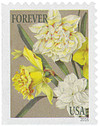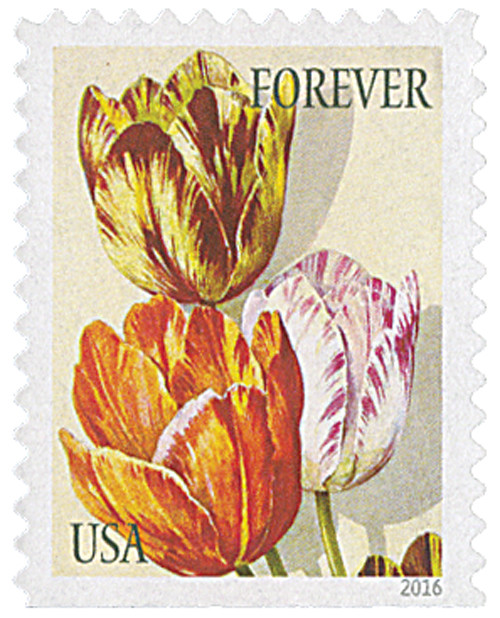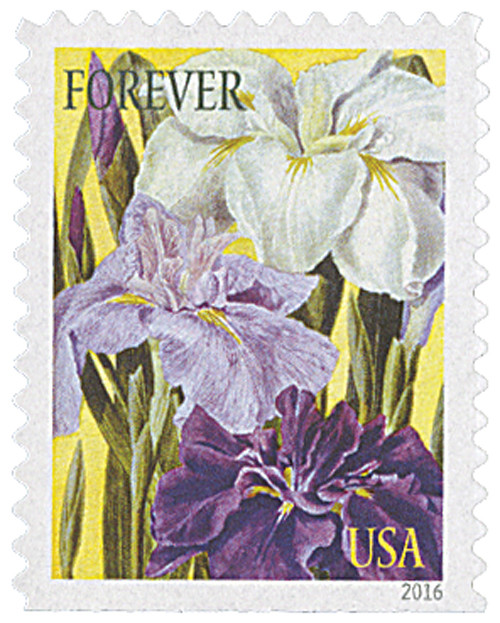
# 5051 - 2016 First-Class Forever Stamp - Botanical Art: Jonquils
US #5051
2016 Jonquils – Botanical Art
- Celebrates botanical artwork in American nursery catalogs printed between 1891 and 1912
Stamp Category: Definitive
Set: Botanical Art
Value: 49¢ First Class Mail Rate (Forever)
First Day of Issue: January 29, 2016
First Day City: Atlanta, Georgia
Quantity Issued: 60,000,000
Printed by: Ashton Potter
Printing Method: Offset
Format: Booklets of 10 OR Double-sided booklets of 20
Tagging: Nonphosphored type III, block tag applied
Why the stamp was issued: To continue the tradition of printing floral-themed US stamps.
About the stamp design: Pictures jonquils from an American nursery catalog printed between 1891 and 1912. The catalog was from The New York Botanical Garden’s Nursery and Seed Catalog Collection.
First Day City: The First Day of Issue Ceremony was held at the American Philatelic Society’s AmeriStamp/Southeastern Stamp Expo. at the Hilton Atlanta in Atlanta, Georgia.
About the Botanical Art set: 10 stamps all picturing different artwork from a 100+ year old American nursery catalog. Species pictured include: corn lilies, tulips, dahlias, stocks, roses, Japanese irises, petunias, and jonquils.
History the stamp represents: Once the pursuit of ryalty and the upper class, flower gardens became widespread during the 19th century. At the same time, exotic plants from around the world found their way to local markets. The seed and nursery trade expanded as a result, aided by railways, improved mail service, and the distribution of catalogs.
Seed catalogs were among the earliest forms of marketing mail campaigns. Innovators quickly realized gardening tips and encouragement would stimulate interest and increase sales.
Directions for sowing seeds were soon added, including planting depth and times for different hardiness zones. Advice on harvesting and storage was also included, along with tips on cooking and other uses.
To broaden interest and sales, seed catalogs were designed to appeal to women, who were not usually gardeners by tradition. Catalog covers featuring beautiful floral arrangements became popular, while several inside pages explained how ladies could convey secret messages in their bouquets by the types of flowers they contained.
Modern gardeners often turn to old seed catalogs for information on long-forgotten varieties, finding a wealth of information and cherished works of art.
US #5051
2016 Jonquils – Botanical Art
- Celebrates botanical artwork in American nursery catalogs printed between 1891 and 1912
Stamp Category: Definitive
Set: Botanical Art
Value: 49¢ First Class Mail Rate (Forever)
First Day of Issue: January 29, 2016
First Day City: Atlanta, Georgia
Quantity Issued: 60,000,000
Printed by: Ashton Potter
Printing Method: Offset
Format: Booklets of 10 OR Double-sided booklets of 20
Tagging: Nonphosphored type III, block tag applied
Why the stamp was issued: To continue the tradition of printing floral-themed US stamps.
About the stamp design: Pictures jonquils from an American nursery catalog printed between 1891 and 1912. The catalog was from The New York Botanical Garden’s Nursery and Seed Catalog Collection.
First Day City: The First Day of Issue Ceremony was held at the American Philatelic Society’s AmeriStamp/Southeastern Stamp Expo. at the Hilton Atlanta in Atlanta, Georgia.
About the Botanical Art set: 10 stamps all picturing different artwork from a 100+ year old American nursery catalog. Species pictured include: corn lilies, tulips, dahlias, stocks, roses, Japanese irises, petunias, and jonquils.
History the stamp represents: Once the pursuit of ryalty and the upper class, flower gardens became widespread during the 19th century. At the same time, exotic plants from around the world found their way to local markets. The seed and nursery trade expanded as a result, aided by railways, improved mail service, and the distribution of catalogs.
Seed catalogs were among the earliest forms of marketing mail campaigns. Innovators quickly realized gardening tips and encouragement would stimulate interest and increase sales.
Directions for sowing seeds were soon added, including planting depth and times for different hardiness zones. Advice on harvesting and storage was also included, along with tips on cooking and other uses.
To broaden interest and sales, seed catalogs were designed to appeal to women, who were not usually gardeners by tradition. Catalog covers featuring beautiful floral arrangements became popular, while several inside pages explained how ladies could convey secret messages in their bouquets by the types of flowers they contained.
Modern gardeners often turn to old seed catalogs for information on long-forgotten varieties, finding a wealth of information and cherished works of art.















